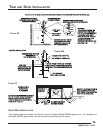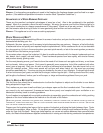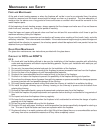
FIREPLACE OPERATION
A F
EW WORDS OF CAUTION
Beware of burning certain material in your fireplace. Among these are plastics, poison ivy twigs and stems,
and chemically treated woods such as discarded poles and railroad ties. These not only create air pollution,
but can induce extreme irritation for some individuals.
Use hemlock, spruce, juniper and other resinous woods with caution. They contain moisture pockets which,
upon heating, “pop” with considerable vigor.
Always use a fire screen. And always “bank” a fire, or at least push all unburned fuel to the rear of the grate
before leaving a fire unattended. Do not use this fireplace as an incinerator.
Because the termination of the chimney above the roof is exposed to wind and cold and the pressure changes
these and other environmental conditions may cause, a sufficient chimney draft may be hard to establish at
times. At other times the draft may be sufficiently disrupted to cause smoke to spill from the fireplace opening.
If problems with chimney draft occur, help start chimney draft before you build a fire by holding a piece of
burning paper near the flue opening at the top of the firebox to preheat the chimney. If smoke spills from the
fireplace opening after the fire is burning, open a window on the up wind side of the house that is far enough
away form the fireplace that the wind will not blow across the fireplace opening, push the burning wood as near
the back of the fireplace as possible, and if the fireplace is equipped with glass doors, close them.
DO NOT LEAVE CHILDREN OR PHYSICALLY OR MENTALLY HANDICAPPED, OR SENILE PERSONS
ALONE WITH A BURNING FIREPLACE.
You’ll need a minimum of three logs, preferably four, to make a good fire. Add kindling and new logs as needed
to rekindle a dying fire. New logs should be added at the rear grate after raking the coals toward the front. D
O
NOT OVERFIRE THE FIREPLACE. Overfire conditions may be created by large amounts of kindling, building scraps,
or other improper fuels.
Ashes, important because they form a bed of glowing coals, should only be left to accumulate within an inch or
two of the bottom of the grate. Excess ashes can be used to check a flaming fire; or to “bank” your fire, cover
the logs with ashes. A “banked” fire will hold glowing coals for 8-10 hours, thereby saving a fire for later use.
WOOD VS. FOSSIL FUELS
Compared to fossil fuels, a full cord of dry hickory weighs about two tons and is approximately equal in heating
value to a ton of hard coal. On a pound basis, heavy hardwoods have about half the heating value of coal. The
tabulation shows the relative densities and heat values of a variety of dry woods. Varieties at the top of the list
(Dogwood) burn longer and those near the bottom (White Pine) ignite and burn quicker. A combination of both
light and heavy wood is desired.
SPECIES DENSITY HEAT VALUE
Dogwood .70-.79 100-107
Hickory .70-.74 100
Oak .60-.73 86-99
Black Locust .69-.70 95-98
Beech .64-.66 89-91
Hard Maple .58-.65 83-88
Birch .55-.64 79-86
Apple .58-.62 83-84
SPECIES DENSITY HEAT VALUE
Ash .57-.61 81-82
Southern Pine .51-.60 73-81
Elm .50-.59 71-80
Cherry .50-.52 70
Douglas Fir .45-.51 64-69
Spruce .41-.44 59
Redwood .33-.40 47-54
White Pine .35-.37 50
28
53D9028. Rev 1 03/03


















